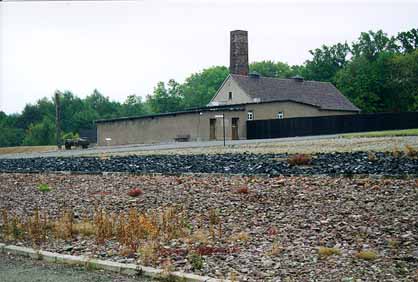Buchenwald Concentration Camp Crematorium The photograph above shows the Buchenwald crematorium and the pathology annex, which today houses several exhibits. The crematorium is located to the right of the gate house as you enter the camp. In the foreground of the photo, you can see rocks which have been arranged to show where the barracks formerly stood. Unlike Dachau and Sachsenhausen, where the crematorium was outside the camp fence and hidden from the prisoner's view by trees or a wall, all of the Buchenwald inmates could see this building, which was at the top of a slope. The pathology lab was located in an annex built onto the crematorium; this was where autopsies were done to determine the cause of death. The crematorium, which is one of the few buildings still standing in the former Buchenwald concentration camp, was built by the SS in 1942. It replaced a smaller crematorium which had been built between the end of 1939 and the beginning of 1940 and had started operation in the middle of 1940. Prior to that, bodies were taken to the municipal Krematory in Weimar and other nearby towns. The corpses were temporarily stored in a shed near the east gate in the vicinity of the camp Zoo. The Buchenwald crematorium was equipped with brick ovens made by the Topf & Sons company in nearby Erfurt. This company also made the ovens which were installed in Auschwitz-Birkenau in June 1943. The photo below shows the east gate of the former Buchenwald concentration camp with the crematorium in the background. A wooden fence, stained a dark brown, surrounds the courtyard where executions were sometimes carried out.  The award-winning photo above was taken in 2001 by Doug Richter-Bisson, a photographer from Canada, who submitted it to us for publication. Doug told us that he "set out to produce a photojournalistic rendition of the scene, and not just have the crematorium coldly represented." Home
|